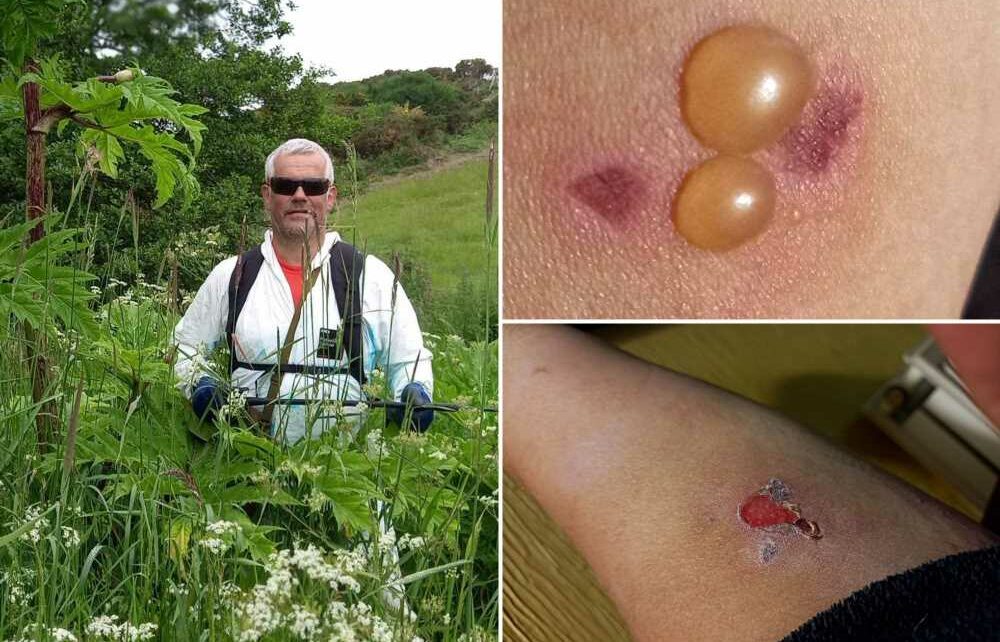AN URGENT warning has been issued after a man was burnt by a plant worse than Japanese knotweed – and he is still in pain years later.
Martyn Ferguson, from Aberdeenshire, Scotland, has been battling giant hogweed for six years, clearing it from local riversides in protective clothes.
But it only took one "careless" moment for the dreaded plant to leave him with painful blisters.
Martyn said: "We had been treating giant hogweed for the previous five or six weeks prior to being burnt.
"I was burnt due to me being careless, on the very last day and hour of the season.
"While removing my protective coveralls, I must have rubbed sap on my bare arm – it's the only time I've been burnt in six years whilst treating giant hogweed."
The giant hogweed’s sap stops the skin protecting itself against sun rays, leading to gruesome burns when exposed to natural light.
Part of what makes it so dangerous is the fact that it causes no immediate pain – so its victims may continue to burn in the sunshine heedless of any problem.
And it only takes a moment of exposure for the sap to do its work.
Mr Ferguson continued: "I was unaware I'd managed to get sap on my arm – it reacts to sunlight and it was several hours before I started to experience symptoms.
Most read in The Sun
Three dead and van tries to run others over as man arrested over 'murders'
Hilarious moment City hero Grealish is carried by Walker after huge booze-up
Major pharmacy chain to close 237 branches in supermarkets
Hamilton 'in love triangle' with Shakira & 60-year-old Hollywood star
"Prior to the blistering, my arm was warm going to hot, and incredibly itchy.
"The skin appeared very red, then started to blister – it came up in large liquid-filled blisters which eventually burst.
"After they burst, I treated the open wounds with antiseptic cream – they took several weeks to heal properly."
WHAT IS GIANT HOGWEED?
Giant hogweed is a close relative of cow parsley and it originally came from Southern Russia and Georgia.
The plant can reach more than 10ft in height – but gardeners are encouraged to get rid of it as it can cause severe skin burns.
It is widely distributed in the wild and can pose a serious risk to people who are unaware of the damage it can cause.
Chemicals in the sap can cause photodermatitis or photosensitivity, where the skin becomes very sensitive to sunlight, according to the RHS.
People who have come into contact with the plant may suffer blistering, pigmentation and long-lasting scars.
The UK also has a native hogweed, which will be familiar to gardeners and walkers – it is much smaller than a giant hogweed and causes less severe burns and reactions.
The giant hogweeds were introduced into Britain and Europe from the Caucasus Mountains in the 19th century.
But they soon escaped from cultivation and the first wild population was recorded in Cambridgeshire in 1828, soon becoming common across the country.
The giant hogweed looks similar to cow parsley, with thick bristly stems that are often purple-blotched, and white flowers.
Martyn, from Turriff, knew how to treat the wound so avoided a hospital visit.
But the injury is still sensitive to daylight a year later, becoming mildly itchy in the sun.
Now the 57-year-old is warning others to beware of the hated plant.
He said: "My injury was mild in comparison – it took a while to heal, it was hot, painful and incredibly itchy.
"Severe burns must be horrendous. In bad cases, even after a burn has healed you need to protect the wound site from sunlight as your skin can re-blister.
"If you come across any giant hogweed plants, unless you know what you're doing and have the correct PPE, leave it well alone.
"Even if you're properly trained and have the correct PPE, you must still be very careful."
Giant hogweed is native to the Caucasus, but was introduced to Britain as an ornamental plant in 1817, and its spread has now got out of control.
Mike Duddy, of the Mersey Basin Rivers Trust, said in 2015 that the giant hogweed was "without a shadow of a doubt, the most dangerous plant in Britain".
If exposed to the plant, you should thoroughly wash the area that made contact and keep it out of sunlight for a few days, the Woodland Trust advises.
Mr Ferguson, who offers his services through his own company, Handy Gardens, asked for Brits to report any sightings of the plant to their local river trust.
Read more on The Sun
Urgent warning to check sunscreen bottles after woman reveals horror ‘burn’
I’m a fairground whizz – how to win at the games, despite some being rigged
Japanese knotweed is one of Britain’s most invasive plants.
The plant grows and spreads rapidly and can cause significant damage to property and infrastructure.
Source: Read Full Article












